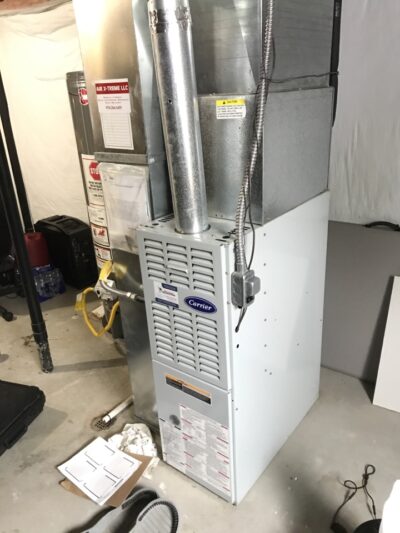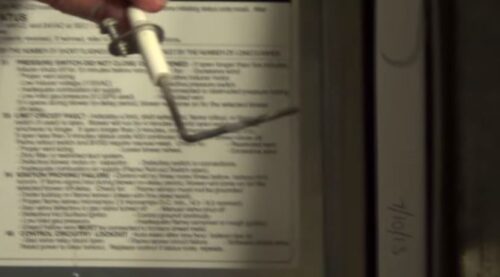Carrier Furnace Code 34 and 14 [Fixed]
Are you dealing with status code 34 on your carrier furnace? If so then you are in the right place.
Carrier furnace code 34 is an ignition proving fault that indicates that the flame was not sensed during the trial for the ignition period. Typically, the control will trigger the ignition process 3 more times before going to status code 14.

Let’s look at the following chart which summarizes the triggers for status code 34 and what you can do about it to reset this status code
PS: See link for carrier furnace troubleshooting manual near bottom of this guide
Possible Causes for Carrier Furnace Code 34 And Solutions
| CAUSE | FIX |
| Dirty flame sensor | Clean or replace flame sensor |
| Bad/ cracked ignitor | Replace hot surface ignitor |
| Bad flame sensor | Replace flame sensor |
| Bad gas valve | Replace gas valve |
| Bad furnace Control board | Replace furnace control board |
Read also: Carrier Furnace Code 33 [Fixed]
Dirty Bad flame sensor
A flame sensor is an important safety component found in furnaces. It takes the form of a straight or L-shaped rod, and its primary role is to detect the presence of flames on the burner assembly.
In the event that the furnace is started, but the flame sensor fails to detect flames, it initiates a sequence where signals are sent to the control board.
Consequently, the control board halts the gas supply, effectively preventing the possibility of gas leakage.
Over time, as a result of the combustion process, oil and debris accumulate on the flame sensor.

This buildup often obstructs the sensor’s ability to accurately detect flames. Consequently, this could trigger issues such as an unreliable or “Dirty Bad” flame sensor.
It’s important to note that the flame sensor’s role only becomes significant once the burners are activated. At this point, it ensures that the combustion process is stable and safe.
Flame sensors have a lifespan of approximately 5 years. If you’ve attempted cleaning the sensor but the problem persists, it might be an indication that the flame sensor has fulfilled its duty in the furnace.
Read also: Bryant Furnace Code 33 [Solved]
Solution: Maintaining and Replacing Flame Sensors
To address a “Dirty Bad” flame sensor issue, follow these steps:
Access the Flame Sensor: Open the protective cover that shields the burner assembly. Typically located behind the burners, accessing the flame sensor requires a nut driver.
Cleaning: Gently clean the flame sensor using a method like sandpaper or a material like a $5 bill. Be cautious not to be overly aggressive during cleaning, as this might reduce the sensor’s lifespan.
If, after cleaning, the problem persists, there might be an issue with the sensor itself:
Replacement: If the flame sensor is determined to be faulty, the most effective solution is to replace it with a new one. This can ensure the continued safety and efficiency of your furnace.
Read also: Carrier Furnace Code 32 [Solved]
Bad ignitor
A faulty ignitor is another common trigger for the status code 34 on a Carrier thermostat. If you’re using one of these newer furnaces, chances are you have a hot surface ignitor. A damaged ignitor will result in ignition failure.
However, identifying a malfunctioning ignitor can be challenging unless you employ a multimeter to test its continuity.
Typically situated on the right side of the burner, the ignitor features two connected wires and is plugged into the control board’s wiring.
If the ignitor shows no continuity, it is undoubtedly defective, and you’ll need to obtain a replacement.
Bad Gas Valve
Another potential reason for encountering status code 34 on a Carrier furnace is a faulty gas valve. A malfunctioning gas valve on a Carrier furnace can prevent ignition by failing to deliver the proper amount of gas to the burners.
This can happen if the valve is stuck closed, limiting gas flow, or if it’s not opening fully due to a mechanical issue.
Without the correct gas flow, the furnace lacks the necessary fuel-air mixture required for combustion, resulting in ignition failure and triggering status code 34.
To troubleshoot a bad gas valve this, you can use a voltmeter to test the voltage at the gas valve while the igniter is glowing. If you measure 24 volts AC, it could indicate a problem with the gas valve.
However, if you don’t detect this voltage, it suggests a possible issue with either the control board or a poor connection between the control board and the valve.
Read also: Goodman Furnace 4 Flashes [Solved]
Bad Control Board
If none of the above troubleshooting steps fixes status code 34, then you may have a malfunctioning furnace control board.
The control board is responsible for coordinating the furnace’s ignition sequence. If the control board is malfunctioning, it might fail to send the appropriate signals to initiate the ignition process.
The faulty control board might struggle with signal transmission, sensor communication, timing regulation, or relay functions, all of which can prevent the ignition system from functioning correctly in the Carrier furnace.
At this point, you might also want to seek a second opinion from an on-site technician. If you indeed have a defective furnace control board, replacing it with a new one is the best solution to this problem.
Final thoughts
To wrap up, that is all you need to know about Carrier furnace code 34. In principle, furnace error codes are only about 30% accurate in indicating the actual issue; the remaining 70% could be attributed to something else.
See carrier furnace troubleshooting manual here
I hope you have managed to resolve this error code. If you are still in the process of identifying the actual problem, I would encourage you to contact an on-site technician for assistance.
See how to properly clean a flame sensor here (Youtube)
![Goodman Furnace Solid Red Light On But Furnace Not Working [Solved]](https://thermostating.com/wp-content/uploads/2023/08/Goodman-furnace.jpg)
![Furnace Pilot Light Is On But No Heat Coming [Fixed]](https://thermostating.com/wp-content/uploads/2023/09/straight-flame-sensor.jpg)
![Furnace Shuts Off After 30 Seconds [Fixed]](https://thermostating.com/wp-content/uploads/2023/08/furnace-blower-compartment-768x396.jpg)
![Carrier Furnace Code 33 [Fixed]](https://thermostating.com/wp-content/uploads/2023/08/carrier-furnace-set-up-768x434.jpg)
![Carrier Furnace Code 32 [Solved]](https://thermostating.com/wp-content/uploads/2023/08/carrier-furnace-768x427.jpg)
![Furnace Running But Not Blowing Air [Fixed]](https://thermostating.com/wp-content/uploads/2023/09/furnace-not-blowing-air.jpg)